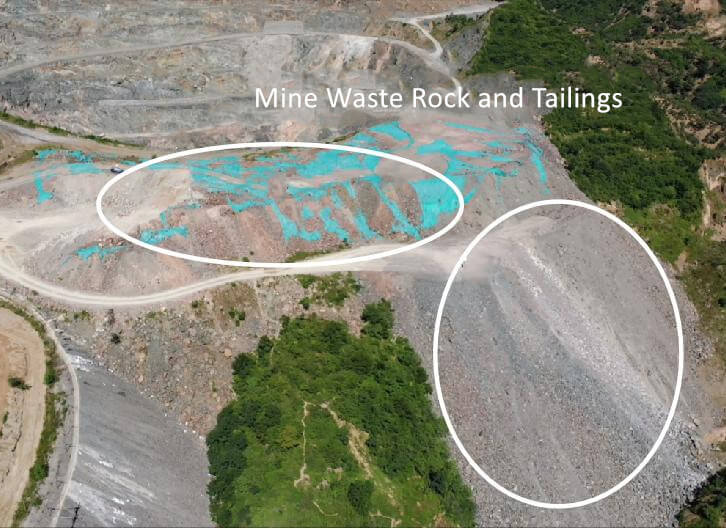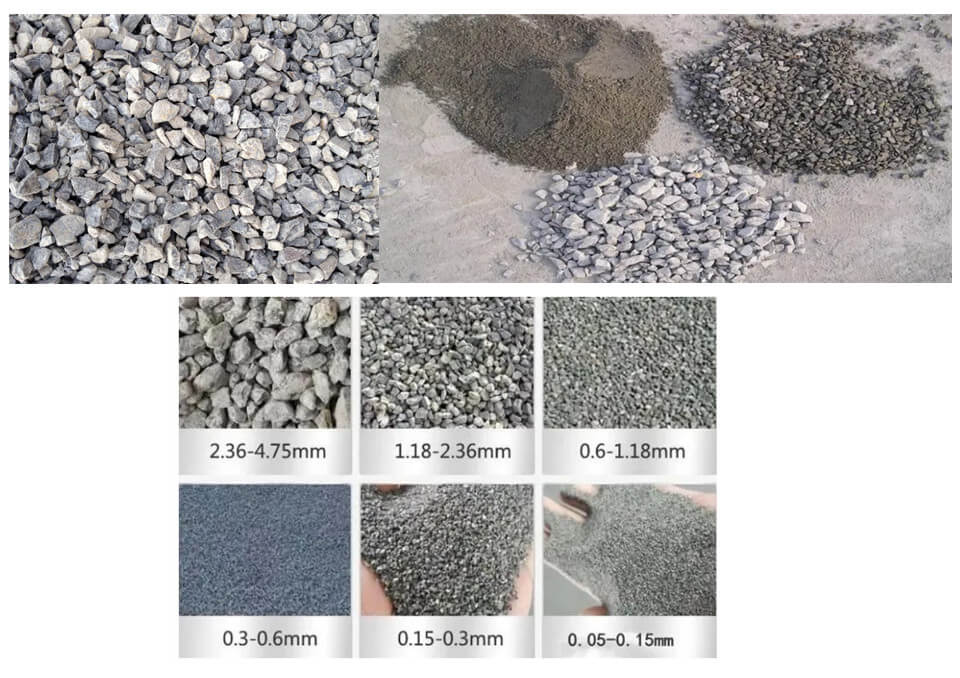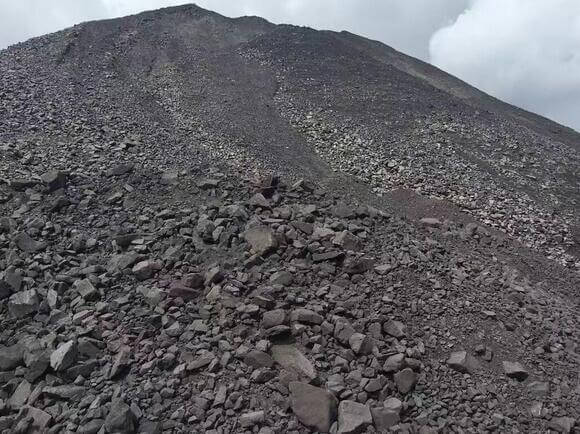Mine waste is the economically unproductive rock or minerals removed directly from the ore extraction. This waste is usually generated during the ore extraction because it does not contain enough valuable minerals.
Tailings are the fine-grained waste materials that remain after the ore has been through the beneficiation or smelting process. These materials usually contain small amounts of unextracted minerals or metals, but their economic value is not enough for further processing.
Although both mine waste and tailings are by-products of mining activities, they have different sources, compositions, and treatment methods. Waste is usually worthless rock generated in the early stages of ore extraction, while tailings are the fine-grained material that remains after the ore has been processed. Both need to be properly managed and handled to reduce the impact on the environment.

Uses of Mine Waste Rock And Tailings
Many people know that mine waste rock and tailings can be used to produce recycled sand and gravel aggregates, but they are not particularly familiar with other uses. Here we introduce some uses of mine waste rock and tailings.
1. Aggregate of sand and gravel
Aggregate of sand and gravel is the largest, indispensable, and irreplaceable basic material used in the construction of infrastructure projects such as buildings, roads, and bridges, but it is a non-renewable resource. Mines produce a large amount of waste rock and tailings, and the use of these tailings resources can completely or partially replace the aggregate of sand and gravel.
Many waste rocks in mines can be used as coarse and medium-grained aggregates. When evaluating aggregates, the physical properties and chemical composition of the rock should be considered. Both depend on the type of rock, but the degree of crack development and weathering should also be considered. Among the physical properties, those with high strength are of course advantageous; in addition, the elastic modulus should also be considered, and the closer the elastic modulus is to cement mortar, the better. At the same time, it is also required that the waste rock used as aggregate should not contain too much flaky or fibrous rock debris. Generally speaking, limestone, fine sandstone, quartzite, relatively finely crystallized granite, diorite, gneiss, and basalt are all suitable as aggregates.
2. Concrete fine aggregate
We need to consider the coarse and medium aggregates when using tailings as fine aggregate for concrete. Generally speaking, tailings sand is better than sea sand, because sea sand often contains salt and chloride ions, which can easily cause steel bars to rust, and the tailings have a rough surface and are angular, which can increase the strength of concrete. However, tailings must be used as fine aggregate, requiring a certain particle size. When the particle size does not meet the requirements, the tailings need to be screened. Because coarse sand makes concrete drier, the viscosity decreases, and the workability is poor; super fine sand not only makes concrete extremely easy to segregate but also requires a large amount of water, thereby increasing the amount of cement.
3. Using waste rock as railway ballast
The requirement for railway ballast is that it is not easy to break under vibration pressure. Rocks with developed foliation or stratification are certainly not suitable for use as ballast, while limestone, basalt, etc. are more suitable for use as railway ballast.
4. Cement basic & corrective raw materials and mixed materials
- The basic raw materials of cement are limestone and clay ore. Limestone, clay rock, shale, etc. are all common waste rocks in mines. In addition, tailings containing corresponding components can also be used as basic raw materials. It should be noted that for the use of limestone and clay rock, do not just mechanically copy the grade index requirements in the past specifications.
- Iron corrective raw materialsand siliceous corrective raw materials, these two raw materials can also use tailings. The tailings of some metal mines have high iron content and can be sold to cement plants for use as iron correction raw materials; the tailings of some iron mines contain both large amounts of silicon and iron and can also become correction raw materials.
- Adding an appropriate amount of mixed materials to cementcan not only improve certain properties of cement but also save the consumption of basic materials. Mixed materials are divided into filling and active materials. At present, blast furnace slag and fly ash have become commonly used active mixed materials for cement. Some tailings are also suitable for use as mixed materials, such as tailings of vanadium-titanium iron ore deposits in amphibolite. In addition, waste rocks (or tailings) with a high content of amorphous substances, such as glassy volcanic rocks, tuff, pumice, etc., can also be used as active mixed materials.

5. Used to produce various bricks
At present, gangue bricks have become one of the main wall-building materials to replace clay bricks. Not only gangue red bricks can be fired, but also hollow bricks. Many shale waste stones are also suitable for brick making, but the energy consumption is higher than that of gangue bricks. In addition, uncalcined gypsum tailings are used as raw materials, ground and mixed with a certain proportion of ground slag and fly ash. Under the action of composite activators, they can be used to produce new wall materials such as gypsum tailings bricks and hollow blocks.
Many tailings can be used to make steam-cured bricks/autoclaved bricks. This kind of brick is made by cementing the tailings with a certain gelling agent and then curing with steam, or even high-pressure steam.
Square bricks are a kind of ceramic imitation stone products that have just become popular in China. They can have a variety of shapes and colors and can be arbitrarily combined into various patterns. Generally, 30~50% of tailings can be added, and then some ceramic raw materials and colorants are added and fired at 1200~1300℃.
6. Use tailings to enclose ponds and create farmland
Using tailings to enclose ponds and create farmland is a technology that turns river beach wasteland into arable land. The method is to build a 3.5-5 meter high dam with stones on the river beach, and each pond covers an area of about 40 mu; the tailings are directly discharged into the pond, and when the pond is full, it is discharged into another new pond. After the pond is filled with tailings, the river pebbles are buried under the tailings, and about 25 cm of arable soil is covered on it, making this pond arable land. It has been successfully applied in some areas.
7. Use waste rocks and tailings to fill open pits and reclaim farmland
Waste rock or tailings were discharged into the existing open pits in the past and then covered with a certain thickness of arable soil to make it arable land. This is the method used by some mines.
8. As raw material for producing silica bricks
Silica bricks are acidic refractory materials, widely used in glass-melting furnaces, coke ovens hot blast furnaces, and other facilities. Their load softening temperature is as high as 1640~1670℃. The requirements for silica brick raw materials are that the content of SiO2 must not be less than 96%, and there must not be too many impurities such as Al2O3, N2O, K2O, etc. The tailings of some kaolin mines fully meet this requirement, and the waste rocks of some mines also have quartzite or quartz sandstone that can meet this requirement.
9. Used in the production of calcium carbonate
Papermaking white mud, carbide slag, phosphogypsum, alkali slag, etc. contain a large amount of calcium hydroxide or calcium oxide, which can be used as raw materials for the production of light calcium carbonate.
10. Used as raw material for heavy calcium carbonate
Heavy calcium carbonate is mainly used as the main raw material or filler in industries such as plastics, rubber, glass, ceramics, and toothpaste. It mainly uses calcite and dolomite as the main raw materials, and its requirements are high purity, low iron content, no sulfur, and harmless to the human body. In some ore deposits, there are large calcite veins or fragments of dolomite veins or pure marble and dolomite in the waste rock, which can be selected from the waste rock as this raw material.
11. Tailings recovery: Recovering valuable components from tailings
Carrying out tailings reselection is an important measure to improve resource utilization, and it is also conducive to reducing tailings emissions. From the results achieved by tailings recovery, it can be seen that it not only improves the recovery rate of resources but also brings huge economic benefits to enterprises.

In the mining industry, industrially developed countries in the world have set waste-free mines as the development goal of mines, and the comprehensive utilization of tailings as a symbol of a country’s scientific and technological level and economic development. The resource utilization of solid waste is particularly urgent, and its recycled materials can replace some artificial and natural sand and gravel aggregates to achieve recycling.
